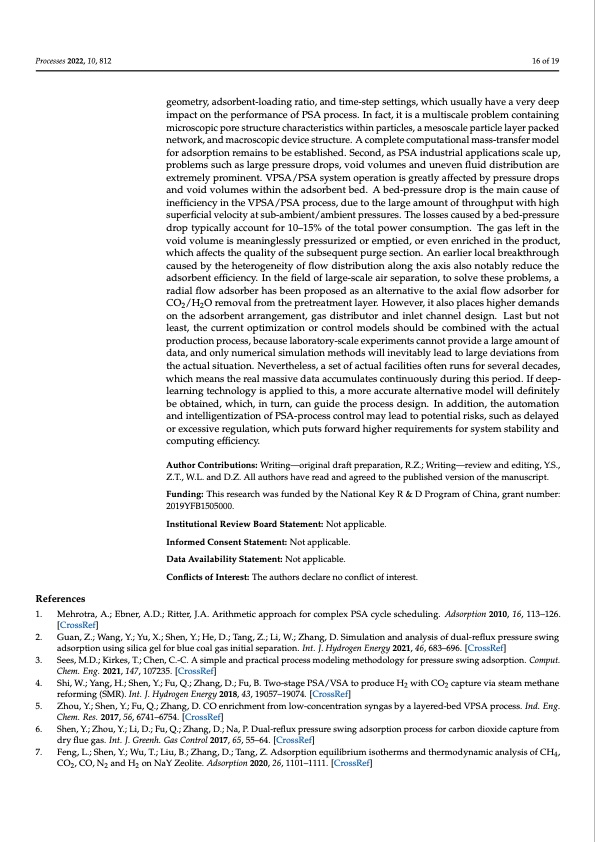
PDF Publication Title:
Text from PDF Page: 016
Processes 2022, 10, 812 16 of 19 References geometry, adsorbent-loading ratio, and time-step settings, which usually have a very deep impact on the performance of PSA process. In fact, it is a multiscale problem containing microscopic pore structure characteristics within particles, a mesoscale particle layer packed network, and macroscopic device structure. A complete computational mass-transfer model for adsorption remains to be established. Second, as PSA industrial applications scale up, problems such as large pressure drops, void volumes and uneven fluid distribution are extremely prominent. VPSA/PSA system operation is greatly affected by pressure drops and void volumes within the adsorbent bed. A bed-pressure drop is the main cause of inefficiency in the VPSA/PSA process, due to the large amount of throughput with high superficial velocity at sub-ambient/ambient pressures. The losses caused by a bed-pressure drop typically account for 10–15% of the total power consumption. The gas left in the void volume is meaninglessly pressurized or emptied, or even enriched in the product, which affects the quality of the subsequent purge section. An earlier local breakthrough caused by the heterogeneity of flow distribution along the axis also notably reduce the adsorbent efficiency. In the field of large-scale air separation, to solve these problems, a radial flow adsorber has been proposed as an alternative to the axial flow adsorber for CO2/H2O removal from the pretreatment layer. However, it also places higher demands on the adsorbent arrangement, gas distributor and inlet channel design. Last but not least, the current optimization or control models should be combined with the actual production process, because laboratory-scale experiments cannot provide a large amount of data, and only numerical simulation methods will inevitably lead to large deviations from the actual situation. Nevertheless, a set of actual facilities often runs for several decades, which means the real massive data accumulates continuously during this period. If deep- learning technology is applied to this, a more accurate alternative model will definitely be obtained, which, in turn, can guide the process design. In addition, the automation and intelligentization of PSA-process control may lead to potential risks, such as delayed or excessive regulation, which puts forward higher requirements for system stability and computing efficiency. Author Contributions: Writing—original draft preparation, R.Z.; Writing—review and editing, Y.S., Z.T., W.L. and D.Z. All authors have read and agreed to the published version of the manuscript. Funding: This research was funded by the National Key R & D Program of China, grant number: 2019YFB1505000. Institutional Review Board Statement: Not applicable. Informed Consent Statement: Not applicable. Data Availability Statement: Not applicable. Conflicts of Interest: The authors declare no conflict of interest. 1. Mehrotra, A.; Ebner, A.D.; Ritter, J.A. Arithmetic approach for complex PSA cycle scheduling. Adsorption 2010, 16, 113–126. [CrossRef] 2. Guan, Z.; Wang, Y.; Yu, X.; Shen, Y.; He, D.; Tang, Z.; Li, W.; Zhang, D. Simulation and analysis of dual-reflux pressure swing adsorption using silica gel for blue coal gas initial separation. Int. J. Hydrogen Energy 2021, 46, 683–696. [CrossRef] 3. Sees, M.D.; Kirkes, T.; Chen, C.-C. A simple and practical process modeling methodology for pressure swing adsorption. Comput. Chem. Eng. 2021, 147, 107235. [CrossRef] 4. Shi, W.; Yang, H.; Shen, Y.; Fu, Q.; Zhang, D.; Fu, B. Two-stage PSA/VSA to produce H2 with CO2 capture via steam methane reforming (SMR). Int. J. Hydrogen Energy 2018, 43, 19057–19074. [CrossRef] 5. Zhou, Y.; Shen, Y.; Fu, Q.; Zhang, D. CO enrichment from low-concentration syngas by a layered-bed VPSA process. Ind. Eng. Chem. Res. 2017, 56, 6741–6754. [CrossRef] 6. Shen, Y.; Zhou, Y.; Li, D.; Fu, Q.; Zhang, D.; Na, P. Dual-reflux pressure swing adsorption process for carbon dioxide capture from dry flue gas. Int. J. Greenh. Gas Control 2017, 65, 55–64. [CrossRef] 7. Feng, L.; Shen, Y.; Wu, T.; Liu, B.; Zhang, D.; Tang, Z. Adsorption equilibrium isotherms and thermodynamic analysis of CH4, CO2, CO, N2 and H2 on NaY Zeolite. Adsorption 2020, 26, 1101–1111. [CrossRef]PDF Image | Numerical Research on the Pressure Swing Adsorption Process

PDF Search Title:
Numerical Research on the Pressure Swing Adsorption ProcessOriginal File Name Searched:
processes-10-00812-v2.pdfDIY PDF Search: Google It | Yahoo | Bing
CO2 Organic Rankine Cycle Experimenter Platform The supercritical CO2 phase change system is both a heat pump and organic rankine cycle which can be used for those purposes and as a supercritical extractor for advanced subcritical and supercritical extraction technology. Uses include producing nanoparticles, precious metal CO2 extraction, lithium battery recycling, and other applications... More Info
Heat Pumps CO2 ORC Heat Pump System Platform More Info
| CONTACT TEL: 608-238-6001 Email: greg@infinityturbine.com | RSS | AMP |